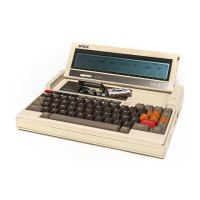be so
if
the computer prints
it
out.
Some extensions are standardised and are recognised by
CP
1M
or
particular
programming languages
or
applications languages.
Examples
of
common extensions are:
.ASM
.BAK
.BAS
.COM
.DAT
.DOC
.MSG
.OBJ
.SUB
.TXT
.$$$
ASseMbly language source file
BAcKup file
BASIC program source file
Directly executable COMmand file
DATa
file
DOCument file
A MeSsaGe file
OBject
code for machine code program
Command file for use with the SUBMIT program
TeXT file
Temporary file
Some terms used in this list which are commonly met are:
SOURCE CODE. This
is
text which
is
converted
or
interpreted by a program
to create machine readable codes.
It
is
in a form which
is
understandable provid-
ed you can understand the language it was written in.
OBJECT
CODE. This
is
code directly readable by the computer as a set
of
instructions.
COMMAND
FILE
or
COM FILE. This
is
the most important file you will
meet under the
CP
1M
operating system.
It
is
basically a program file which
is
loaded into memory
to
execute a set
of
instructions. There are a number
of
commands built in to
CP/M.
A COM file
is
sometimes known as a TRAN-
SIENT COMMAND since it
is
temporarily loaded into the TRANSIENT PRO-
GRAM
AREA
or
TPA,
i.e. the
part
of
the computer's memory set aside to
run
programs.
3.2.1 Referring to file names -
(ambiguous/unambiguous file names and wildcards)
In
many cases
CP
1M
or
a program requires you to use the complete, exact file
name.
In
this case there
is
no
doubt
which file
is
being referred to. The name
is
UNAMBIGUOUS as there
is
only one file
of
that
name. Sometimes you may
3-4
wish
to
refer
to
several similar file names.
For
example they may be all the files
beginning with the letter
"E"
or
all the files with
extension"
.COM".
In
this
case the file name
is
AMBIGUOUS.
In
references
to
CP
1M
you will frequently
see these terms abbreviated:
ufn
afn
means
means
Unambiguous File Name
Ambiguous File Name
In
using ambiguous file names, you need
to
tell
CP
1M
some further informa-
tion, so
that
it can have a precise idea what you mean.
In
order to do this you
can use the
"?"
characters to denote
"any
character"
and
the"
*"
to
denote
"any
group
of
characters". The
"?"
and"
*"
characters are known as WILD-
CARD characters.
For
example:
*.COM
NAME. *
Warning:
means any file name with the extension .COM
means all the files with the primary name
"NAME"
but
with any extension,
ego
NAME.COM, NAME.BAS,
NAME.DAT
means any file name beginning with E which has the
extension .COM
means all files beginning with E no matter what their
extension
you
cannot use:
*P.
* to mean all the files ending
in
the letter
"P".
CPIMwill
treat this
as meaning every single file. This is important to remember
if
you
are
erasing files from a disk.
????????
.COM
????COM
A???*
?S???BAS
?????ROP.*
*.B??
means any file with the extension
.COM
because there
are eight (i.e. the maximum) wildcard characters.
means any file
of
not more
than
four characters in
length, which has the extension .COM.
means any file beginning with the letter
"A"
which has
not
more
than
four characters.
means any file whose second character
is
"S",
which
has five
or
less characters, and has the .BAS extension.
means any file ending in the characters
"ROP".
means all files whose extensions begin with the charac-
ter
"B".
3-5

